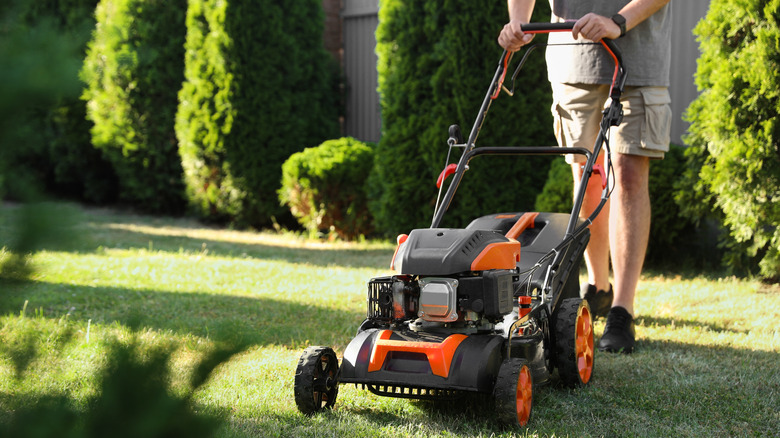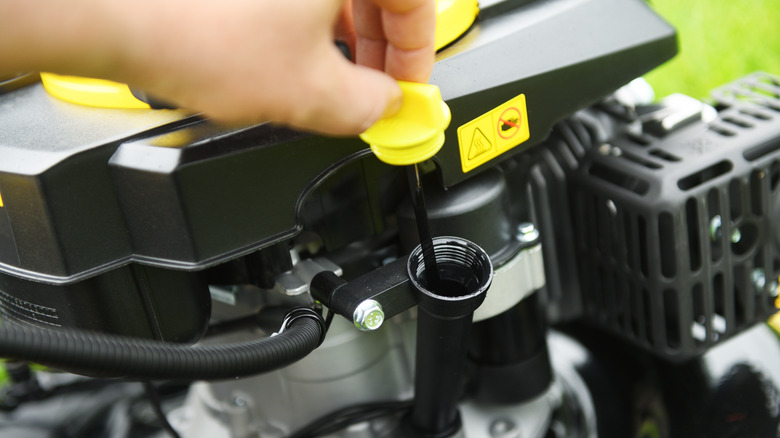How Often You Should Change The Oil In Your Lawn Mower (& The Best Way To Do It)
You probably contemplate when you should change the oil in your car, but what about the oil in your lawn mower? Since lawn mower oil serves the same function as other engine oils, keeping the machinery lubricated and cool during use, it needs changing just like the oil in your car. Without regular oil changes, you can say goodbye to your trusty lawn mower—and goodbye to freshly cut grass.
Over time, oil degrades, making it less effective at regulating the temperature of an engine and at keeping moving parts lubricated. Lawn mowers typically have 4-stroke engines, which cycle through four phases: intake, compression, ignition, and exhaust. If dry machinery grinds or stops during one of those phases, it will disrupt all of the lawn mower's processes. An oil change ensures your machine keeps doing its job well at every phase, increases its lifespan, and can help you mow your lawn more efficiently, saving you time and money. Both push mowers and riding mowers follow the same principles for oil maintenance, so the same techniques for changing apply regardless of which kind of mower is taking up space in your garage or shed.
When to refresh lawn mower oil
As a rule, lawn mower oil should be changed in the spring or summer, which ensures any oil that has degraded over the winter is flushed out. Since this is also peak grass-growing season, it keeps your mower running smoothly during a period of heavy use. If you're still unsure about timing, change the oil after every 50 hours of run time. Outside of regular yearly changes, your lawn mower might need new oil if you've replaced the engine recently or if you're using it in demanding conditions where it must tackle mud, wet grass, or large swaths of land. Check the oil after every 10 to 20 hours of use to monitor the quality and get an estimate of when the oil will next reach a low level. Checking the oil is not one of the lawn mower maintenance tasks you should be doing after every mow, but keep it in mind to do regularly.
Though petroleum-based oil has been a standard for many years, biodegradable lubricants are emerging as an eco-friendly alternative. These lubricants are better for both your yard and you, as they cut down on harmful emissions. Whether you opt for traditional or modern oil, you should look for a product intended for small engines that has a viscosity of 5W-30 or 10W-30.
Changing lawn mower oil
While the task may seem intimidating at first, changing your lawn mower's oil is simple. Before getting started, you'll need a few tools, including an oil drain pan, old towels, a fresh oil filter, and personal protective equipment such as eyewear and gloves. After donning your safety equipment, start up your mower. Let the engine run for one to two minutes, which will warm up the oil and help it move. Then, cut it off and disconnect the spark plug. Pull out the dipstick, setting it aside, and place your drain pan beneath the mower. Unscrew the oil plug, allowing the oil to drain completely from the valve. Remove the old filter and dispose of it.
Once all the old oil is out, repeat the process in reverse by sliding in the new filter, replacing the oil plug and refilling the tank, and replacing the dip stick. Clean up any excess oil drips with your old towels, reconnect the spark plug, and turn on the engine to make sure it's running properly. Check the dipstick to make sure the oil level is appropriate. If everything seems to be in working order, you're finished. The only thing left to do is get rid of the old lawn mower oil at an appropriate location, such as an auto store.


